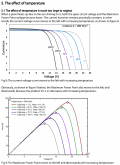I sure would like to see measured test results. How many amp-hrs do you estimate are under the shaded area of your plot? Compare those gained AH to the ones lost over the entire day by operating at a higher voltage level. That difference may be 2%.
A challenging ask as I did these tests at least a couple of years ago and since I've had my panels connected based on my tests to harvest maximum energy i.e. connected in series. I only had two panels in the test, both 100W. So in theory I would be able to harvest around 400Wh, 2% of that is 8Wh. So the question is was the total Wh generated in the series configuration more than 8Wh above the total generated in parallel? My gut instinct is telling me it was in tens of Wh's, but that unfortunately is well within the vagaries of solar output over the days I was doing the test.
An inconclusive answer but, if you lift up out of the detail for a moment and assume that this 'higher Voc / Vbat differential = higher inefficiency' is real, then I can also assume my MPPT also incurred these losses during my tests, and yet I can say with confidence that the series-connected array always won out over the parallel-connected array, every time in every test. I remember this quite distinctly.
One question that I would like to know the answer to is what happens if all three strings of cells in a panel are shaded, in a series connected pv array. does one of the bypass diodes, bypass the whole panel, or will the whole string be brought down by the shaded panel?
Bypass diodes do not block the flow of current from shaded strings, they just avoid the scenario where the entire array's current flows through the shaded string causing power to be dissipated within the shaded cells and 'hot spots' to form. The current that is generated (
I mean, unless the entire string is shaded i.e. zero current) still flows from the shaded string with the remaining current flowing through the bypass diode. So what happens? You just get less current, therefore less power from the panel. I would expect some impact on Voc but probably not a lot.
This lowered panel power effects the MPP of the array, so the MPPT controller will re-baseline by altering the effective resistance of the load as presented to the array, therefore once again running at the maximum power point. and the cycles starts again, hundreds of times a second.
The more shading occurs, the less current is generated, the more bypass diodes have to work, the more they themselves dissipate power, the less overall power you get.
I would expect this to be overall quite a linear relationship i.e. % shading is approximately directly proportional to power output, but I have never tested this.
That'd probably be done for power loss, only take a single 0.6v hit across one diode instead of 1.2v for two.
You'll find that most, if not all, PV panels use Schottkey diodes, which only have 0.2 - 0.3V drop across them in operation.




